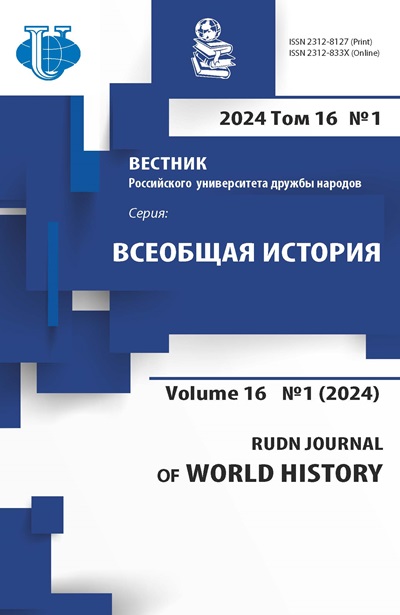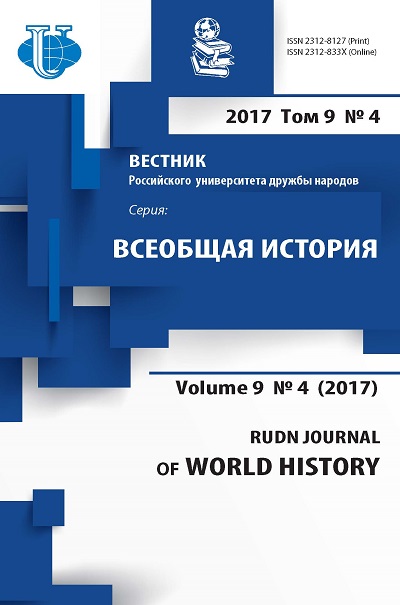“The Oirats-Ogeleds... crossed the Mankan River”: the ethnoreligious situation at the Oirats in the middle of XV - the beginning of XVI centuries
- Authors: Kitinov BU1
-
Affiliations:
- Peoples’ Friendship University of Russia
- Issue: Vol 9, No 4 (2017)
- Pages: 370-382
- Section: Articles
- URL: https://journals.rudn.ru/world-history/article/view/18033
- DOI: https://doi.org/10.22363/2312-8127-2017-9-4-370-382
Cite item
Full Text
Abstract
The article examines the problem, which so far had not been studied by the historical science - the fate of the Elet Oirats, who, according the Oirat and Kalmyk sources, suddenly had departured “to the west”. The author suggests, that the Elets’ exodus did take place in the past, the reasons probably lied in the ethnic and religious history of this people. The Choros clan, which headed the Elets, was of Turkic origin, and had had the close relationship with the Muslim rulers of Moghulistan, and there was a certain role of Islam among some clan’s members. At the time of the descendants of the famous Oirat ruler Esen Taisha (who actively supported Buddhism), there had happened the religious disputes between Amasanjee (the youngest son of Esen, an adherent of Buddhism) and his sons - Ibrahim and Ilyas (Esen’s grandsons, Muslims). The author hypothesizes that, being the leaders of the Elets, the brothers took a significant part of this Oirat people to Moghulistan, where they, most likely, almost all were exterminated by Alachi-khan (Ahmad-khan). Those events led to the significant transformative processes both among the Oirats themselves and in the fate of the Choros - a new confederation was created by the Oirats, where Buddhism was perceived not only as a religion but also as an ideology of society, and the remaining descendants of Esen, who left among the Oirats, had formed the new peoples: Derbets and Jungars. The very name “Choros” almost completely disappeared from the chronicles.
About the authors
B U Kitinov
Peoples’ Friendship University of Russia10/2 Miklukho-Maclaya St., Moscow, 117198
References
- Авляев Г.О. Происхождение калмыцкого народа (середина IX - первая четверть XVIII вв.). М. - Элиста, 1994.
- Бабур Захириддин. Бабур намэ. Баку, 2011.
- Бартольд В.В. Очерк истории Семиречья. Верный, 1898.
- Бартольд В.В. Калмыки // Сочинения. Т. 5. Работы по истории и филологии тюркских и монгольских народов. М., 1968. С. 538-540.
- Батур Убаши Тюмень. Сказание о дербен ойратах // Лунный свет. Калмыцкие историко-литературные памятники. Элиста, 2003. С. 125-154.
- Бичурин И.Я. Историческое обозрение ойратов или калмыков с 15 столетия до настоящего времени. Элиста, 1991.
- Габан Шараб. Сказание об ойратах // Лунный свет. Калмыцкие историко-литературные памятники. Элиста, 2003. С. 84-107.
- Екеев Н.В. Дорбен-ойраты (к проблеме этимологии и этнической идентификации) // Мир Центральной Азии. Улан-Удэ, 2002. Т. 1. С. 124-131.
- Извлечения из «Мин ши сань сиюй и» // Китайские документы и материалы по истории Восточного Туркестана, Средней Азии и Казахстана XIV-XIX вв. Алматы, Гылым, 1994.
- История Калмыкии с древнейших времен до наших дней. Элиста, 2009. Т. 1.
- Козин С.А. Сокровенное сказание. Монгольская хроника 1240 г. «Юань чао би ши». М.-Л., 1941.
- Лубсан Данзан. Алтан тобчи («Золотое сказание»). М., 1973.
- Лыткин Ю. Материалы для истории ойратов // Лунный свет. Калмыцкие историко-литературные памятники. Элиста, 2003. С. 390-441.
- Санчиров В.П. Письменные памятники по истории ойратов XVII-XVIII веков. Элиста, 2016.
- Санчиров В.П. «Илэтхэл-шастир» как источник по истории ойратов. М., 1990.
- Сухбаатар На, Баярсайхан Д. Хойдын туух (История хойтов). Улаанбаатар, 2016.
- Успенский В. Страна Кукэ-Нор, или Цинхай, с прибавлением краткой истории ойратов и монголов, по изгнании последних из Китая, в связи с историей Кукэ-Нора // Записки Императорского Русского Географического Общества. 1880. Т. 6. C. 59-196.
- Хайдар Мирза Мухаммад. Тарих-и Рашиди. Ташкент,1996.
- Badai Ho. Oyirad-monghol-in tüüke soyol-in sudulal (Изучение истории и культуры ойрат-монголов). Urumji, 2004.
- Birtalan Á. An Oirat Ethnogenetic Myth in Written and Oral Traditions (A Case of Oirat Legitimacy) // Acta Orientalia Academiae Scientiarum Hungaricae. 2002. Vol. 55. Iss. 1-3. Р. 69-88.
- Bretschneider E. Medieval Researches from Eastern Asiatic sources. London, 1888.
- Irwin R. “Futuwwa”: Chivalry and Gangsterism in Medieval Cairo // Muqarnas. 2004. Vol. 21. Essays in Honor of J. M. Rogers. http://www.jstor.org/stable/1523352 (дата обращения: 12.08.2016.)
- Landa I. Oirats in the Ilkhanate and the Mamluk Sultanate in the Thirteenth to the Early Fifteenth Centuries: Two Cases of Assimilation into the Muslim Environment. URL: http://mamluk.uchicago.edu/MSR_XIX_2016_Landa.pdf (дата обращения: 1.12.2016.)
- Ngag dbang blo bzang rgya mtsho. Gangs can yul gyi sa la spyod pa’i mtho ris kyi rgyal blon gtso bor brjod pa’i deb ther. (История, рассказывающая о деяниях высших царей и министров на земле Страны снегов). Delhi, 1967.
- Pelliot P. Notes Critiques d’Histoire Kalmouke. Part 1. Paris, 1960.
- Richardson H.E. The Karma-Pa Sect. A Historical Note // Journal of the Royal Asiatic Society. 1958. October. Р. 139-164.
- Saγang Sečen. Erdeni-yin Tobči (‘Precious Summary’). A Mongolian Chronicle of 1662. Canberra, 1990.
- Serruys H. The Office of Tayisi in Mongolia in the fifteenth Century // Harvard Journal of Asiatic Studies. 1977. Vol. 37. № 2. Dec. Р. 353-380.













